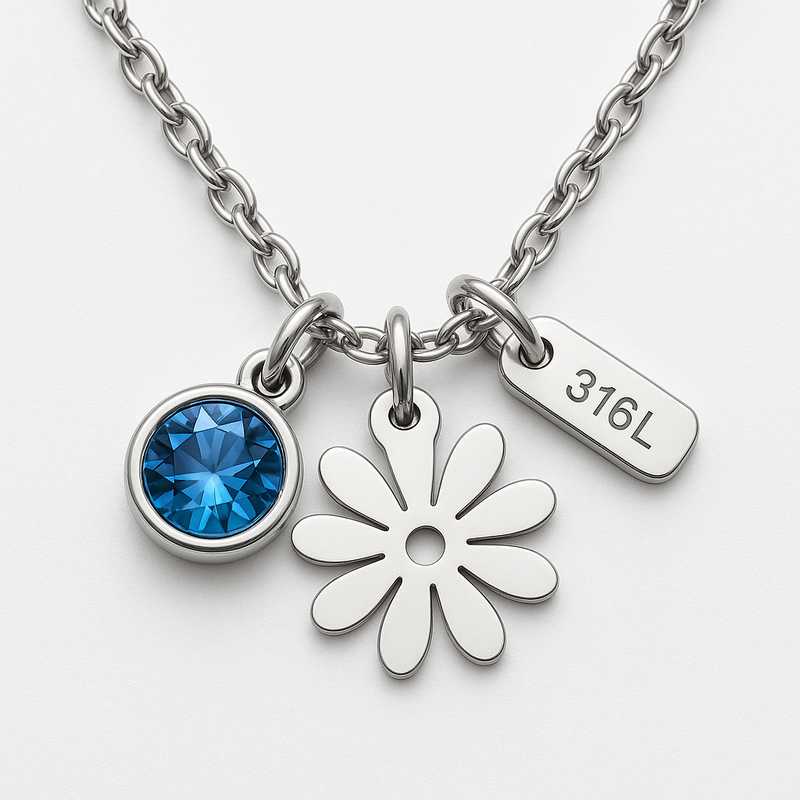Precision & Sustainability: The Art of Stainless Steel Jewelry

Explore 304 vs 316L corrosion resistance, laser tech, green plating, and advanced eco-friendly OEM/ODM processes for custom charm necklaces
In the rapidly evolving landscape of stainless steel jewelry manufacturing, balancing precision craftsmanship with environmental responsibility has never been more essential. As B2B buyers increasingly seek premium, custom-made charm necklaces—such as birth month flower and birthstone designs—manufacturers must combine cutting-edge techniques with eco-conscious processes. This page dives deep into the material science and innovative technology behind today’s most resilient and sustainable stainless steel jewelry.
Material Science Spotlight: Comparing 304 vs 316L Stainless Steel
Stainless steel alloys are at the core of modern jewelry manufacturing, with 304 and 316L being the most prevalent grades used in OEM/ODM production. Understanding their differences is critical for brands targeting durability, hypoallergenic properties, and environmental resilience.
304 Stainless Steel: Affordable & Versatile
- Contains 18% chromium and 8% nickel
- Offers moderate corrosion resistance, suitable for daily wear in low-salinity environments
- Popular in fashion jewelry and mid-range charm necklaces
- Less resistant to chlorides and sweat acids—may degrade faster over time
316L Stainless Steel: The Premium Standard
- Also known as “surgical grade” steel, with 16–18% chromium, 10–14% nickel, and 2–3% molybdenum
- Superior corrosion resistance in high-salinity or acidic environments
- Hypoallergenic—ideal for sensitive skin and long-term wear
- Preferred material for high-end, custom charm necklaces, especially in hot, humid climates
Use Case Example: For coastal resort gift shops ordering birthstone necklaces for tourists, 316L ensures long-term brilliance despite exposure to seawater and sunscreen. For officewear fashion lines, 304 may offer a cost-efficient yet polished option.
Advanced Manufacturing: From Laser Precision to Hydraulic Perfection
Today’s stainless steel jewelry manufacturing blends artistry with automation. Several transformative technologies are used to craft intricate birth month flower and gemstone charm necklaces:
Laser Cutting & Etching
- Application: Allows ultra-precise shaping of floral outlines or gemstone bezels
- Benefits: Micron-level detailing with minimal material waste
- Example: Creating 12 distinct flower silhouettes (one per month) with consistently crisp edges and deep texture for embossing
Hydraulic Stamping & Microforming
- Application: For complex multi-layered charm assemblies
- Benefits: Even pressure distribution prevents stress fractures
- Example: Shaping convex birthstone holders or layered petals for a 3D flower effect
Corrosion Patterning
- Application: Intentional surface texturing for design accents
- Technique: Electrochemical corrosion methods applied through precision masking
- Example: Creating frosted floral veins or matte-polished gemstone frames
This fusion of tradition and innovation enables rapid OEM scaling without compromising artistic detail or product longevity.
Green Plating & Eco-Conscious Finishing Processes
With sustainability front and center, plating technologies have transformed. Modern B2B clients increasingly demand ethical, non-toxic finishes that align with environmental regulations and brand values.
Vacuum Plating (PVD)
- Technique: Physical Vapor Deposition (PVD) applies metal layers in a vacuum chamber
- Benefits: No wastewater or chemical discharge, extremely low environmental footprint
- Colors: Popular for rose gold, matte black, champagne silver, and pastel tones
- Durability: 3–5x more wear-resistant than traditional electroplating
Green Electroplating
- Alternative: Cyanide-free and lead-free formulas for traditional finishes
- Techniques: Closed-loop water reuse and smart filtration systems
- Certifications: REACH, RoHS compliance for EU markets
Use Case: One OEM client targeting premium eco-jewelry lines in the Nordic market selected champagne gold PVD plating on 316L stainless steel—resulting in zero rejections and fully passed EU eco-regulation audits.
Eco-Friendly Manufacturing: Closing the Sustainability Loop
Green practices must extend beyond just plating. Responsible stainless steel OEMs now integrate circularity and zero-waste principles across the full production lifecycle.
Waste Recycling Systems
- Metal Reuse: All cut-off stainless steel fragments are collected, sorted, and melted for reuse
- Dust Capture: Air filtration traps micro-particles during cutting and polishing
- Impact: Reduces raw material usage by up to 35% per batch
Water-Efficient Processes
- System: Multi-stage rinse recovery for etching and cleaning stages
- Tech: UV sterilization and pH balance modules allow reuse up to 10 cycles
- Results: Up to 80% reduction in total water consumption
Smart Energy Use
- Automation: AI-controlled heating and pressurizing systems optimize energy draw
- Power: Increasing use of solar-assisted systems in plating and drying lines
OEM Spotlight: A factory in Taiwan reduced annual CO₂ emissions by 22% after implementing laser energy monitoring and switching to recycled water in its finishing tanks. This directly influenced its winning of an EU-based private label contract in 2024.
Conclusion: Make the Smart, Sustainable Choice
As B2B buyers redefine their sourcing strategies around quality, innovation, and ethics, stainless steel jewelry—especially custom birth month flower and birthstone charm necklaces—offers the ideal fusion of aesthetics, durability, and responsibility. Whether you’re creating boutique giftware or mass-market accessories, selecting the right grade of stainless steel, integrating advanced manufacturing techniques, and committing to eco-friendly practices can elevate your brand and build long-term loyalty.
Ready to transform your stainless steel jewelry line? Partner with an OEM/ODM manufacturer that understands the precision of your vision—and the sustainability demands of your market.
